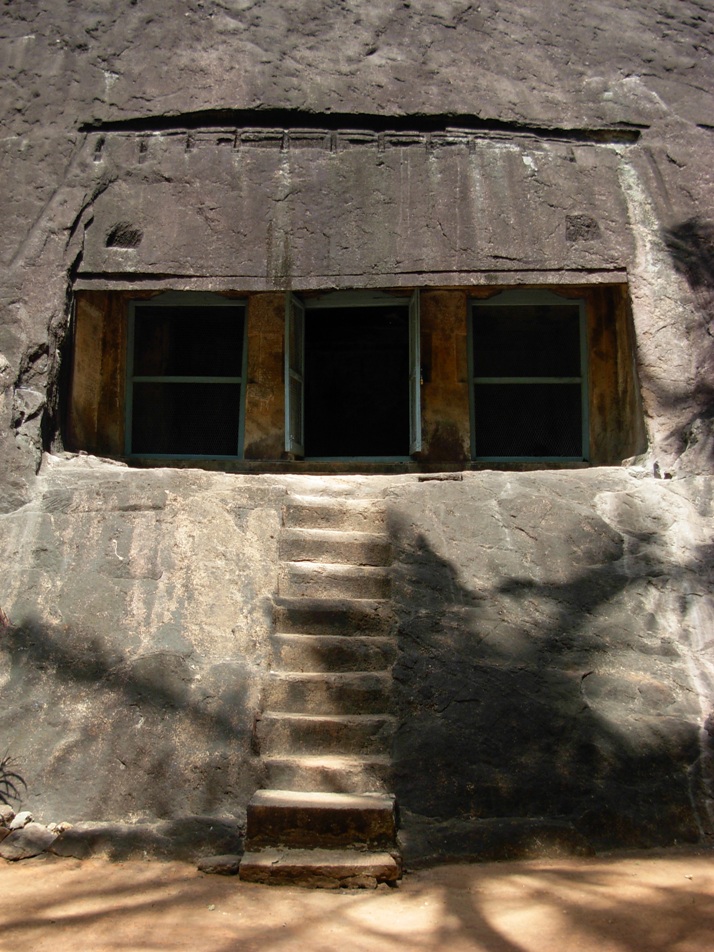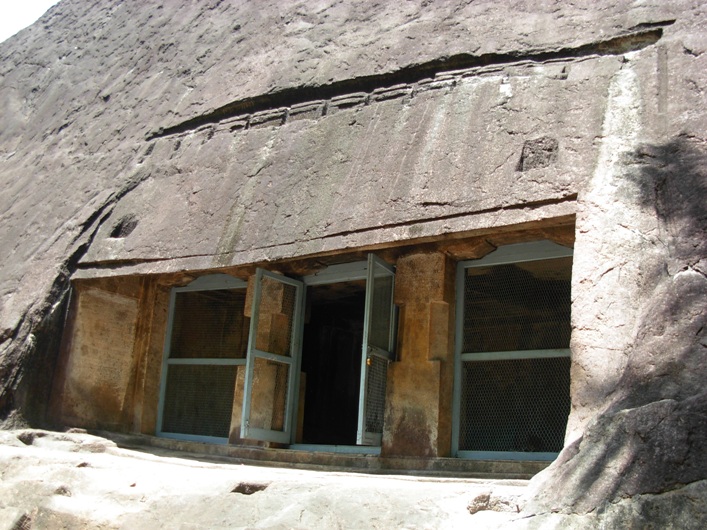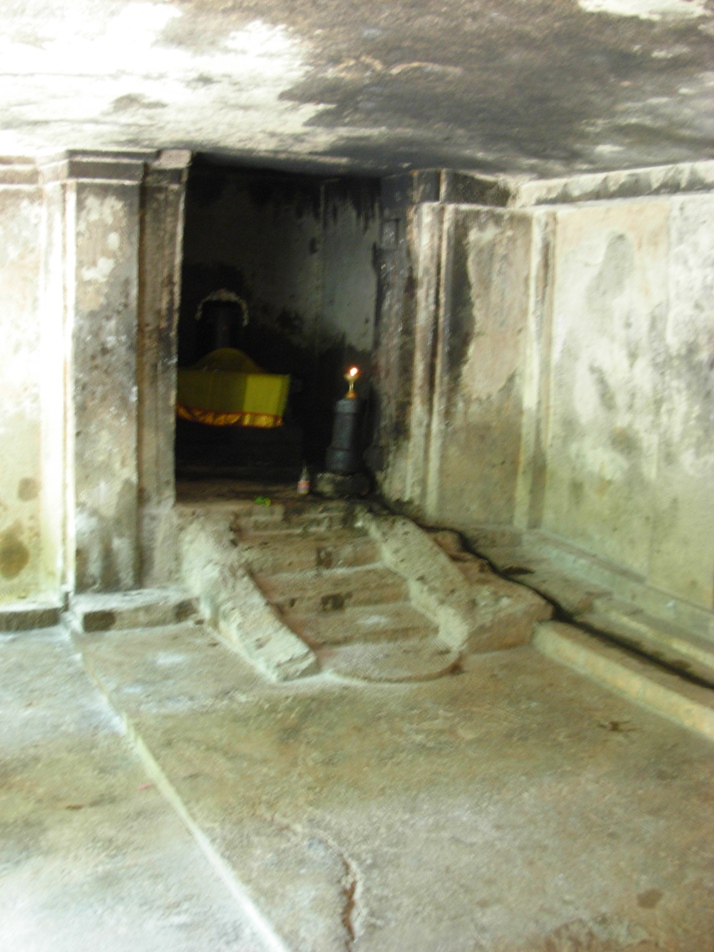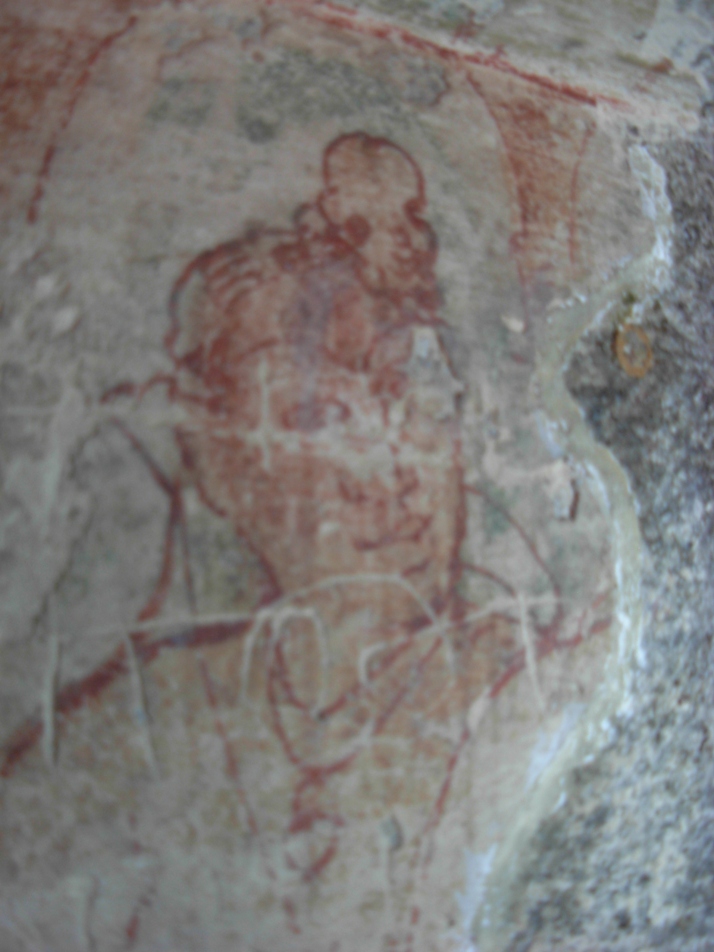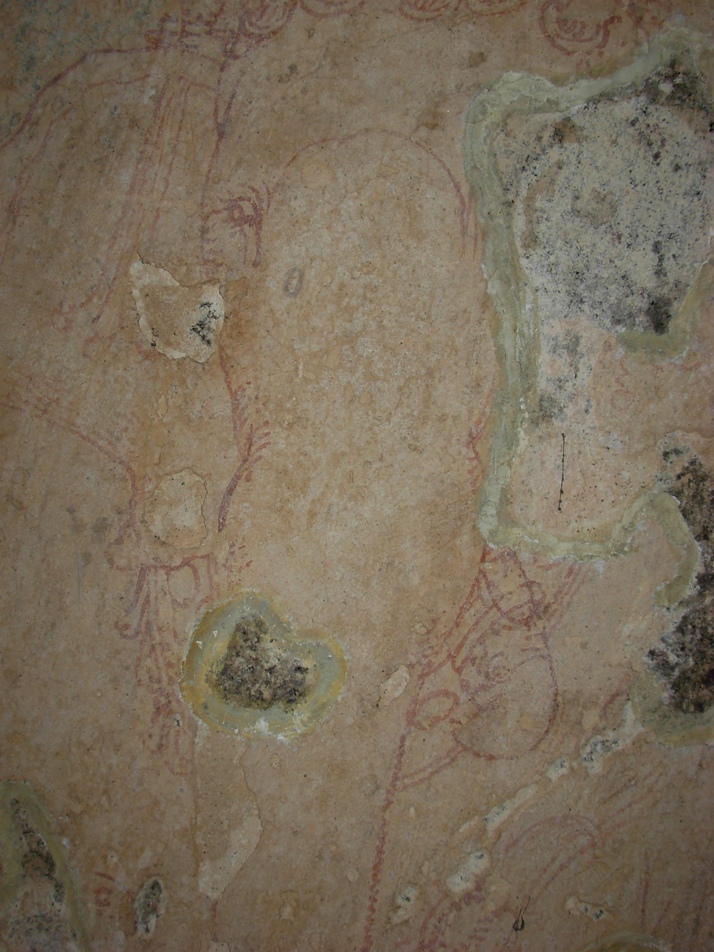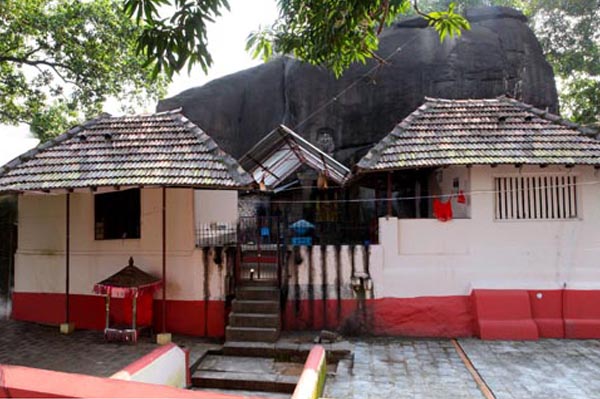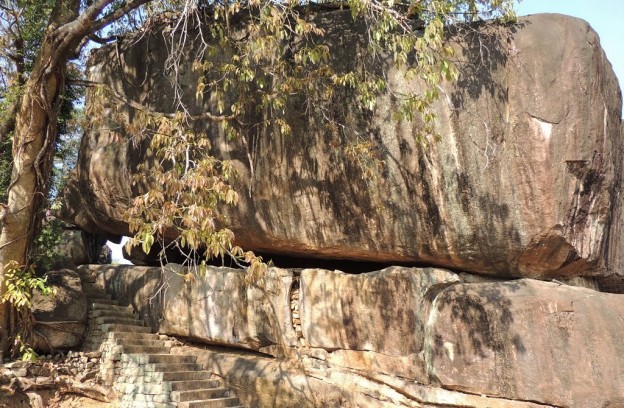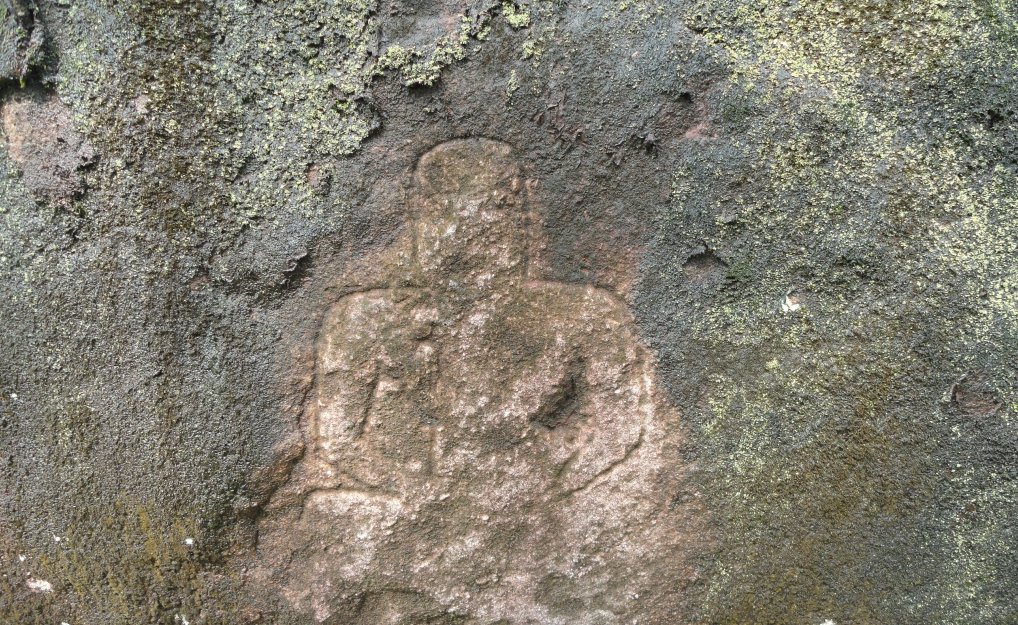
Boothapandi (பூதப்பாண்டி) Rock cut cave temple complex is located in Thovalai (தோவாளை) taluk, Kanyakumari district, Tamil Nadu, India PIN 629852 and the village is forming part of Boothapandi Town Panchayat. The geographical coordinates of Boothapandi are 8°16′22″N latitude 77°26′24″E longitude. As of 2001 India census, Boothapandi had a population of 14,721 and an average literacy rate of 82%. The village lies on the western bank of Pazhaiyar river (பழையாறு), at Thadakaimalai (தடாகமலை) foot hill. Thadakaimalai is believed as the abode of Thadaka in the Indian epic Ramayana and hence the place attains legendary importance. Boothapandi is 13 km (8.00 miles) away from Nagerkoil,

The taluk head-quarters town spans over an area of around five sq km. Boothapandi is surrounded by the lush green fields, grove of coconut trees and the scenic hills of the Western Ghats (Sahyadri) in the background. Azhakiya Pandiapuram (அழகிய பாண்டியபுரம்) is in the north-west (6.2 km), Santhimangalam (சாந்திமங்கலம்) in the south-west (3 km), Thalakudi (தாழக்குடி) in the south-east (3.2 km) and Aralvoimozhi (ஆரல்வாய்மொழி) in the east (11 km). Bhoothalingaswamy Temple (பூதலிங்கஸ்வாமி கோவில்) in Boothapandi is in the tourist map of Kanyakumari district. Thovalai, Kanyakumari, and Vattakottai are nearby tourist destinations. P. Jeevanandham (ப.ஜீவானந்தம்) (1907–1963) also known as Jeeva (ஜீவா), one of the pioneers of the Communist Party of India and political leader, known freedom fighter, social reformer and litterateur was born in Boothapandi.
Legend
Long ago a cow-boy was taking care of cow-herds. The boy got surprised about the low milk yielding cow and suspected that someone is milking the cow without his knowledge. When followed the cow, the cow proceeded straight to a small cave surrounded by bushes and showered the milk there. He saw that a devil (bootha) engaged in drinking milk directly from the cow. People got afraid to go near the cow. The Pandya king was informed about the cow's mysterious action and the king ordered his soldiers to find out the reason for the mysterious events. Soldiers removed the thorny bush and made access inside the cave. They saw that the cow showering the milk over the Shiva-lingam. The king was reported about the mysterious cow showering milk on the Shiva-lingam. The king ordered to built a temple around the cave and the prime deity Shiva-lingam was named as Boothalingaswamy. Thadakaimalai is regarded as the adobe of Thataka, the Yaksha princess-turned-demoness in the Hindu epic Ramayana. The presiding deity of the temple is known as Boothalingaswamy, locally known as Salian Kanda Thirumani.
Architecture
Boothalingaswamy Temple complex (பூதலிங்கஸ்வாமி கோவில் வளாகம்) includes the rock cut cave The cave temple is excavated on the eastern slope of the side of the hillock situated in the middle of the village. This temple comprise an outer prakara, inner prakara and the main cave with a frontward pillared mandapam constituting a large complex. The rock cut cave forms nucleus structure around which temple structures added in the subsequent period of time. Altogether forming the large temple complex.
A large perimeter wall in the periphery encloses the outer prakara. The temple is accessible from four entrances. The western entrance is through three tier gopuram or gateway. The gopuram has granite base and three tiered brick super-structure decorated with stucco images. The pillars, supporting base tier of the gopuram, bear images of the donors (of the temple) appear in folded hand gesture (mudra) On the west face of the tower there are two guards in stucco images appear holding small and large clubs in each of their hands. On top of the boulder towards east of this tower, there are two stucco images: one is a milking cow and the other one is Lord Shiva with trident. .

Legend
Long ago a cow-boy was taking care of cow-herds. The boy got surprised about the low milk yielding cow and suspected that someone is milking the cow without his knowledge. When followed the cow, the cow proceeded straight to a small cave surrounded by bushes and showered the milk there. He saw that a devil (bootha) engaged in drinking milk directly from the cow. People got afraid to go near the cow. The Pandya king was informed about the cow's mysterious action and the king ordered his soldiers to find out the reason for the mysterious events. Soldiers removed the thorny bush and made access inside the cave. They saw that the cow showering the milk over the Shiva-lingam. The king was reported about the mysterious cow showering milk on the Shiva-lingam. The king ordered to built a temple around the cave and the prime deity Shiva-lingam was named as Boothalingaswamy. Thadakaimalai is regarded as the adobe of Thataka, the Yaksha princess-turned-demoness in the Hindu epic Ramayana. The presiding deity of the temple is known as Boothalingaswamy, locally known as Salian Kanda Thirumani.
Architecture
Boothalingaswamy Temple complex (பூதலிங்கஸ்வாமி கோவில் வளாகம்) includes the rock cut cave The cave temple is excavated on the eastern slope of the side of the hillock situated in the middle of the village. This temple comprise an outer prakara, inner prakara and the main cave with a frontward pillared mandapam constituting a large complex. The rock cut cave forms nucleus structure around which temple structures added in the subsequent period of time. Altogether forming the large temple complex.
A large perimeter wall in the periphery encloses the outer prakara. The temple is accessible from four entrances. The western entrance is through three tier gopuram or gateway. The gopuram has granite base and three tiered brick super-structure decorated with stucco images. The pillars, supporting base tier of the gopuram, bear images of the donors (of the temple) appear in folded hand gesture (mudra) On the west face of the tower there are two guards in stucco images appear holding small and large clubs in each of their hands. On top of the boulder towards east of this tower, there are two stucco images: one is a milking cow and the other one is Lord Shiva with trident. .



There are two entrances on the south wall. The westward entrance arch on the south wall is decorated with stucco image of Lord Shiva with consort Uma in Ananda-thandava posture. Also there are two musicians on either side of dancing Shiva. The eastward entrance on the south wall leads to the river Pazhaiyaru. The simple entrance on the eastern wall is located before the sanctum of the prime deity. The entrance on the northern wall leads to the temple tank with a mandapam in middle (நீராழி மண்டபம்)
 |
| Southern inner entrance leads to Pazhaiyaru river |
On the western side to the left of the entrance of the outer prakara adjoining the rock slope is the shrine for Sastha. There is a Pillaiyar shrine under the tree The inner perimeter wall encloses the sanctums of the prime deity, goddess Sivakami, shrines for minor deities, mandapams and inner prakara. The parts of the inner southern and northern walls sit on the rock. There are three entrances leading to the inner prakara: One entrance on the southern wall, other two entrances on the eastern and northern walls. The eastern entrance leads to sanctum of the goddess Sivakami. Another entrance with single tier gopuram leads to the prime sanctum. The southern entrance leads to Pazhaiyaru river. This entrance is supported by adishtana, pillars with square, kattu, square sections, vettu-potikas and prastara components. The ornamental arch houses the celestial wedding event: Lord Vishnu handing-over goddess Meenakshi to Lord Sundareswara.
The inner prakara extends on all three sides except the rocky western side. The inner prakara includes sanctums of god and goddess as well as shrines for minor deities i.e., Kanni Vinayagar, Sastha and Somaskanthar. Somaskantha shrine has sanctum and mukha-mandapam and vimana with nagara griva and shikara. Sastha shrine has eka-tala nagara vimana and sanctum guarded by dwarapalakas (boothas). Kanni Vinayagar shrine has eka-tala vesara vimana and sanctum and mukha-mandapam. Chandigeswara shrine and Dakshinamurti shrine are located on the north and south side prakara of the prime deity. There is a shrine for Lord Muruga and his two consorts Valli and Devayani.
Mandapam
Two mandapams are located before the sanctums of god and goddess and they are known as wedding mandapam (கல்யாண மண்டபம்) and Chettiar mandapam (செட்டியார் மண்டபம்). The wedding hall is supported by ornate pillars with bas relief sculptures. Some are simple pillars sectioned by square kattu and square and some other pillars are composite pillars. The cupid or Kamadeva Manmatha and his love Rathi images appear on a pillar. The Chettiar Hall is also supported by ornate pillars with bas relief sculptures. Some are huge Yali pillars.
Sivagami Amman Shrine
The east facing Sivagami Amman shrine has a two tier vimana, mukha-mandapam and large mandapam. The vimana, built on a granite base with a brick superstructure, has a kapotabanda adhishtana and the vedika component is shown in between the adhishtana and pada (wall). The octagonal (Vishnu-kanta) pilasters with nagabandha pada support the roof. The potikas above the pillars are madalai with nanudal tipped with sharp bud bearing the prastara components that adjoin the roof. The three sides of the external walls are sectioned and shown as simple koshta-panjara. The Adi-tala hara walls have been raised considerably high and the second tala also has hara walls. The stucco images adorn in sala and griva koshtas.
Mandapam
The mukha-mandapam and large mandapams were added before the cave sanctum of the prime deity during later age. The mukha-mandapam has supportive floor, wall supported by square pilasters, taranga potikas and prastara components. Kapota has ornate kudus. The large mandapam can be accessed through entrances at east and south walls. Mandapam is supported by square kattu square kattu square pillars with vettu potikas. The bronze idols are protected in this mandapam. The Vinayaka idol in lalitasana posture is found in the inner mandapam.
Cave Sanctum
The Cave sanctum is .1.71 m in the north-south direction; 1.38 m in the east-west (south wall) direction; 1.46 m in the east-west (north wall) direction; with the height of 1.73 m..The floor, roof and the walls of the cave sanctum are well formed. The sanctum entrance is 0.67 cm in width and 1.60 m in height.
The sanctum houses Boothalingaswamy (பூதலிங்கசுவாமி) in the form of Shivalingam. Shivalingam is sculpted out of the mother rock and the rectangular 'avudai' measures 0.80 cm in length in the north-south; 0.75 cm in width in the east-west directions and 0.52 cm in height. The external faces of avudai is embellished with padabandha adishtana with components such as jagadi (ஜகதி), vritta kumudam (குமுதம்), khanta flanked kampa and pattaka mouldings. The rudra (cylindrical) bana sits on the square avudai. A small pit is shown towards north to receive the anointed water. A water chute is seen running up to the north wall of the sanctum and continued in the east wall of the sanctum.
History
Sivagami Amman Shrine
The east facing Sivagami Amman shrine has a two tier vimana, mukha-mandapam and large mandapam. The vimana, built on a granite base with a brick superstructure, has a kapotabanda adhishtana and the vedika component is shown in between the adhishtana and pada (wall). The octagonal (Vishnu-kanta) pilasters with nagabandha pada support the roof. The potikas above the pillars are madalai with nanudal tipped with sharp bud bearing the prastara components that adjoin the roof. The three sides of the external walls are sectioned and shown as simple koshta-panjara. The Adi-tala hara walls have been raised considerably high and the second tala also has hara walls. The stucco images adorn in sala and griva koshtas.
Mandapam
The mukha-mandapam and large mandapams were added before the cave sanctum of the prime deity during later age. The mukha-mandapam has supportive floor, wall supported by square pilasters, taranga potikas and prastara components. Kapota has ornate kudus. The large mandapam can be accessed through entrances at east and south walls. Mandapam is supported by square kattu square kattu square pillars with vettu potikas. The bronze idols are protected in this mandapam. The Vinayaka idol in lalitasana posture is found in the inner mandapam.
Cave Sanctum
The Cave sanctum is .1.71 m in the north-south direction; 1.38 m in the east-west (south wall) direction; 1.46 m in the east-west (north wall) direction; with the height of 1.73 m..The floor, roof and the walls of the cave sanctum are well formed. The sanctum entrance is 0.67 cm in width and 1.60 m in height.
The sanctum houses Boothalingaswamy (பூதலிங்கசுவாமி) in the form of Shivalingam. Shivalingam is sculpted out of the mother rock and the rectangular 'avudai' measures 0.80 cm in length in the north-south; 0.75 cm in width in the east-west directions and 0.52 cm in height. The external faces of avudai is embellished with padabandha adishtana with components such as jagadi (ஜகதி), vritta kumudam (குமுதம்), khanta flanked kampa and pattaka mouldings. The rudra (cylindrical) bana sits on the square avudai. A small pit is shown towards north to receive the anointed water. A water chute is seen running up to the north wall of the sanctum and continued in the east wall of the sanctum.
History
The cave temple has been named after the presence of Bhoothalingaswamy Temple (Bhoothapandi), which is famous for its sculptures and architecture. The cave temple was excavated by King Pasum Pon Pandyan, the son of Boothapandiyan, Flag post of this temple is very tall and the temple car here is very old and higher in weight. A shrine dedicated for Tamil Poet Avvaiyar is located at 5 km away from Bhoothalingaswamy temple.
Inscriptions
Inscription dated Tamil month Masi, year 1789 cites the installation of flag-post in this temple. Another inscription on the pillar of Nandi Mandapam records one Thanumarthandan.(Tamil தாணுமார்த்தாண்டன்). Remaining nine inscriptions are inscribed on the walls of goddess Sivakami (Amman) shrine. Inscription dated 1578 A.D. records the gift of 25 numbers of five wick oil lamps standing on their stems and pedestals, fabricated in brass (குத்துவிளக்கு) by one Ayyappan Pariyerum Perumal of Boothapandi village. The lamps would be burnt before the prime deity. It also includes land endowments for daily oil consumption. The gift was accepted by Sri Karyam (temple) staff. Signed by Puttur Eswaran, Sri Karyam (temple) accountant,, Kannan Govindan, Treasury accountant and Bootha Nambiyar, Endowment accountant.
Inscription dated 1581 A.D. records the assurance made by Sri Karyam staff to offer one measure of ghee and ten banana and arrange for the celestial dance of prime deity during pooja rituals every month on the Apara (Pitru) Paksham, Ashtami (eighth) tithi day. For this purpose the staff accepted one hundred 'panam' as deposit from one Kali-paappan of Perumanguli desam in Mudala Nadu district, forming part of Malai Mandalam province (Tamil: மலை மண்டலத்து முடாலா நாட்டுப் பெறுமாங்குழி தேசத்துக் காளிபாப்பன்). Another inscription dated 1581 A.D. records the land endowment for pooja rituals and offerings to the prime deity on the Vasantham day, Tamil month Chithirai by one Eswaran Kesavan of Makizhanjeru house in Kadaikkasu Desam (Tamil: கடைக்காசு தேச மகிழஞ்சேறு இல்லத்து ஈஸ்வரன் கேசவன் ). Inscription also cites places like Azhagiya Pandiyapuram, Kadukkarai, Pallacha Peru and Veeraneri Kulam.
Inscription dated 1583 A.D. records the deposit of two hundred 'panam' made for pooja rituals of Lord Dakshinamurti by Pasumpirathu Gangaiyadi Bhattar of Azhagan Azhaga Chaturvedimangalam of Padmanabhanallur (Tamil பத்மநாபநல்லூர் அழகன் அழகச் சதுர்வேதிமங்கலத்துப் பசும்பிறத்து கங்கையாடி பட்டர் ). Yet another inscription dated 1607 A.D. records the deposit of three hundred 'panam' for purposes of early morning rituals (திருப்பள்ளியெழுசசி), ablution (அபிஷேகம்) and offerings (படையல்) to the prime deity in the name of one Sooranai Vendra Adittan of Padmanabhanallur aka. Murungur of Nanjil Nadu (Tamil நாஞ்சில் நாட்டு முருங்கூரான பத்மனாபநல்லூரில் சூரனை வென்ற ஆதித்தன்).
Incomplete inscription dated 1614 A.D. records the deposit of seven hundred 'panam' for purposes of pooja rituals and offerings for procession deity Lord Chandrasekarar during new-moon day procession by one Velayudha Perumal of Mulainallur in Nanjil Nadu (Tamil: நாஞ்சில் நாட்டு முளைநல்லூர் வேலாயுதப்பெருமாள்). Mentions the temple staff and their specific duties during procession as well as minor deities. Another inscription dated 1618 A.D. records the deposit / gift of nine hundred 'panam' for purposes of procession of prime deity and goddess on 'Bharani' star day in Tamil month 'Chithirai' by Settu Silaiyan Ariyakutti, a resident of Tiruvidangur Ravi-varmar (aka. Kulasekara Perumal) street. Specific expenses include feeding the brahmins, Maheswara pooja rituals, rice flakes, Nambimar Adangal, Sala Sambavinai, Namimar Tantra Salavu, evening ablution, camphor etc.
Inscription dated 1658 A.D. records the royal order issued by Elder Thambiran Eraivai Ravivarma,during his stay in the palace of Boothapandi after pooja rituals of the temple. The royal order is in consideration of peasants plea on vacating stay of land charges vs the defense side representation made by the revenue staff. Inscription without date lists out the offerings made by the temple authorities to the Pooja rituals of Lord Chidambareswarar during the Tamil month Markazhi.
Inscriptions
Kanyakumari District Inscriptions volume 5. (கன்னியாகுமாரி மாவட்டக் கல்வெட்டுத் தொகுதி 5) Chennai, Department of Archaeology Government of Tamil Nadu, 1969 pp. 69 - 81 has published eleven inscriptions copied from this temple as well as two inscriptions from North street of this village. The first inscription located nearer to Jeeva library cites two streets in the name of Udhaya Marthandan (உதய மார்த்தாண்டன்) and Boothala Raman (பூதல இராமன்) an asylum to someone under threat also known as Abhaya Dhanam (Jainism) or Anjinan Pukalidam (Tamil அஞ்சினான் புகலிடம்). Another inscription dated 19th day Tamil month Thai 1691 A.D.was inscribed on behalf of Adi Chandeswara endowment. The inscription is about Vadakku Saliyar, weaving community people (Padmasali), who lived in this village during 17th century A.D. They migrated to Vadaseri (near Nagerkoil) after lot of suffering and they were colonized back in Boothapandi village.
Inscription dated 1581 A.D. records the assurance made by Sri Karyam staff to offer one measure of ghee and ten banana and arrange for the celestial dance of prime deity during pooja rituals every month on the Apara (Pitru) Paksham, Ashtami (eighth) tithi day. For this purpose the staff accepted one hundred 'panam' as deposit from one Kali-paappan of Perumanguli desam in Mudala Nadu district, forming part of Malai Mandalam province (Tamil: மலை மண்டலத்து முடாலா நாட்டுப் பெறுமாங்குழி தேசத்துக் காளிபாப்பன்). Another inscription dated 1581 A.D. records the land endowment for pooja rituals and offerings to the prime deity on the Vasantham day, Tamil month Chithirai by one Eswaran Kesavan of Makizhanjeru house in Kadaikkasu Desam (Tamil: கடைக்காசு தேச மகிழஞ்சேறு இல்லத்து ஈஸ்வரன் கேசவன் ). Inscription also cites places like Azhagiya Pandiyapuram, Kadukkarai, Pallacha Peru and Veeraneri Kulam.
Inscription dated 1583 A.D. records the deposit of two hundred 'panam' made for pooja rituals of Lord Dakshinamurti by Pasumpirathu Gangaiyadi Bhattar of Azhagan Azhaga Chaturvedimangalam of Padmanabhanallur (Tamil பத்மநாபநல்லூர் அழகன் அழகச் சதுர்வேதிமங்கலத்துப் பசும்பிறத்து கங்கையாடி பட்டர் ). Yet another inscription dated 1607 A.D. records the deposit of three hundred 'panam' for purposes of early morning rituals (திருப்பள்ளியெழுசசி), ablution (அபிஷேகம்) and offerings (படையல்) to the prime deity in the name of one Sooranai Vendra Adittan of Padmanabhanallur aka. Murungur of Nanjil Nadu (Tamil நாஞ்சில் நாட்டு முருங்கூரான பத்மனாபநல்லூரில் சூரனை வென்ற ஆதித்தன்).
Incomplete inscription dated 1614 A.D. records the deposit of seven hundred 'panam' for purposes of pooja rituals and offerings for procession deity Lord Chandrasekarar during new-moon day procession by one Velayudha Perumal of Mulainallur in Nanjil Nadu (Tamil: நாஞ்சில் நாட்டு முளைநல்லூர் வேலாயுதப்பெருமாள்). Mentions the temple staff and their specific duties during procession as well as minor deities. Another inscription dated 1618 A.D. records the deposit / gift of nine hundred 'panam' for purposes of procession of prime deity and goddess on 'Bharani' star day in Tamil month 'Chithirai' by Settu Silaiyan Ariyakutti, a resident of Tiruvidangur Ravi-varmar (aka. Kulasekara Perumal) street. Specific expenses include feeding the brahmins, Maheswara pooja rituals, rice flakes, Nambimar Adangal, Sala Sambavinai, Namimar Tantra Salavu, evening ablution, camphor etc.
Inscription dated 1658 A.D. records the royal order issued by Elder Thambiran Eraivai Ravivarma,during his stay in the palace of Boothapandi after pooja rituals of the temple. The royal order is in consideration of peasants plea on vacating stay of land charges vs the defense side representation made by the revenue staff. Inscription without date lists out the offerings made by the temple authorities to the Pooja rituals of Lord Chidambareswarar during the Tamil month Markazhi.
Temple Timings : Morning 4:00 A.M. – 11:00 A.M. Evening 4:00 P.M. to 7:30 P.M.
Poojas & Festivals: Pradosham (13th tithi) Day, Special pooja on New moon Full moon days. Annual festival on Thai (Tamil) month and Chithirai (Tamil) month.
How to get there?
The town of Boothapandi is connected to Nagercoil by road.
Nearest railway station: The closest railway station is the Nagercoil Junction Railway Station.
Nearest airport is the Tiruvanandapuram International airport
Reference
The town of Boothapandi is connected to Nagercoil by road.
Nearest railway station: The closest railway station is the Nagercoil Junction Railway Station.
Nearest airport is the Tiruvanandapuram International airport
Reference
- Bhoothalingaswamy Temple Bhoothappandi. Tourism Everyone.
- Bhoothalingaswamy Temple Bhoothappandi. Find My Temple.
- Bhoothalingaswamy Temple, Bhoothappandi (Wikipedia)
- பூதப்பாண்டிக் குடைவரை பல்லவர் - பாண்டியர் - அதியர் குடைவரைகள். மு.நளினி மற்றும் இரா.கலைக்கோவன். சேகர் பதிப்பகம், சென்னை, 2012. பக். 221 - 233.



